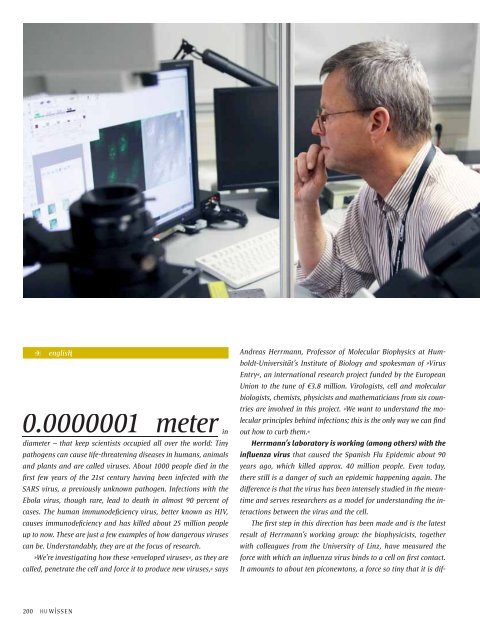hu wissen (pdf) - Exzellenzinitiative - Humboldt-Universität zu Berlin
hu wissen (pdf) - Exzellenzinitiative - Humboldt-Universität zu Berlin
hu wissen (pdf) - Exzellenzinitiative - Humboldt-Universität zu Berlin
Sie wollen auch ein ePaper? Erhöhen Sie die Reichweite Ihrer Titel.
YUMPU macht aus Druck-PDFs automatisch weboptimierte ePaper, die Google liebt.
200<br />
k english Andreas Herrmann, Professor of Molecular Biophysics at <strong>Humboldt</strong>-<strong>Universität</strong>’s<br />
Institute of Biology and spokesman of »Virus<br />
Entry«, an international research project funded by the European<br />
Union to the tune of €3.8 million. Virologists, cell and molecular<br />
biologists, chemists, physicists and mathematicians from six coun-<br />
0.0000001 meterr in<br />
diameter – that keep scientists occupied all over the world: Tiny<br />
pathogens can cause life-threatening diseases in <strong>hu</strong>mans, animals<br />
and plants and are called viruses. About 1000 people died in the<br />
fi rst few years of the 21st century having been infected with the<br />
SARS virus, a previously unknown pathogen. Infections with the<br />
Ebola virus, though rare, lead to death in almost 90 percent of<br />
cases. The <strong>hu</strong>man immunodefi ciency virus, better known as HIV,<br />
causes immunodefi ciency and has killed about 25 million people<br />
up to now. These are just a few examples of how dangerous viruses<br />
can be. Understandably, they are at the focus of research.<br />
»We’re investigating how these »enveloped viruses«, as they are<br />
called, penetrate the cell and force it to produce new viruses,« says<br />
tries are involved in this project. »We want to understand the molecular<br />
principles behind infections; this is the only way we can fi nd<br />
out how to curb them.«<br />
Herrmann’s laboratory is working (among others) with the<br />
infl uenza virus that caused the Spanish Flu Epidemic about 90<br />
years ago, which killed approx. 40 million people. Even today,<br />
there still is a danger of such an epidemic happening again. The<br />
diff erence is that the virus has been intensely studied in the meantime<br />
and serves researchers as a model for understanding the interactions<br />
between the virus and the cell.<br />
The fi rst step in this direction has been made and is the latest<br />
result of Herrmann’s working group: the biophysicists, together<br />
with colleagues from the University of Linz, have measured the<br />
force with which an infl uenza virus binds to a cell on fi rst contact.<br />
It amounts to about ten piconewtons, a force so tiny that it is dif-



